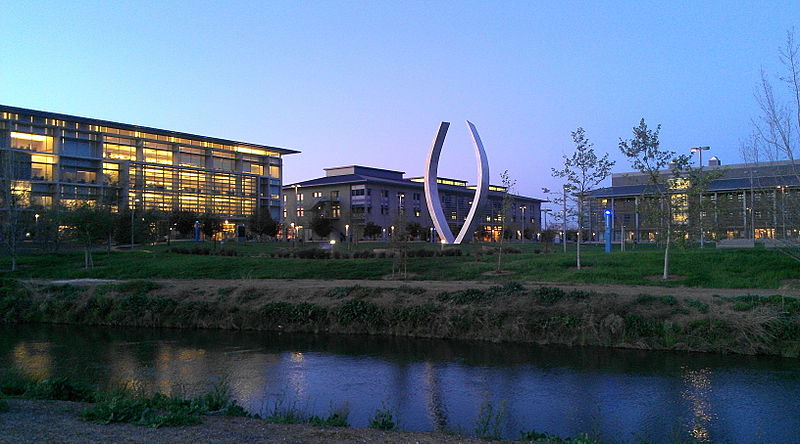The University of California, Merced, received another Leadership in Energy and Environmental Design (LEED) Platinum certification, this time for the Student Services Building.
The award brings the campus total for LEED certifications through the U.S. Green Building Council to 13, with its newest building, under construction, the second Classroom and Office Building (COB2), expected to also achieve Platinum status.
The campus is holding a topping-off ceremony for COB2 at 1 p.m. Tuesday, Dec. 9, with construction crews placing the uppermost beam on the building that’s expected to open in April 2016. Before the beam is placed, the campus community is invited to sign it, leaving marks and messages for anyone who might see it in the future.
UC Merced continues to be the only campus in the nation with LEED certification for all its facilities.
“UC Merced continues to pave the way in sustainable planning and design, frequently outperforming our objectives through the dedication and hard work of the consultants, contractors and staff involved and inspired by the vision of our leadership,” Campus Architect Thomas Lollini said.
The campus earned LEED Silver certification for the Garden Suites Lake View Dining building; eight Gold certificates for its Central Plant, Science & Engineering 1, the first Classroom and Office Building, the Leo and Dottie Kolligian Library, the Joseph Gallo Recreation Center, Sierra Terraces, Early Childhood Education Center and the Logistical Support/Safety Facility; and four Platinum certificates, for the dining expansion, the Social Science and Management building, the Student Activities and Athletic Center and now the Student Services Building. The Early Childhood Education Center is one of the first LEED Gold modular buildings in the country.
Platinum certifications are also pending on two residence halls, called The Summits, and on Science & Engineering 2, which opened this fall.
Earning LEED certifications for design is only one of the campus’s goals. The facilities department is also conducting audits of operations in every building on campus, from energy use to procurement procedures, to earn LEED recognition for the use and maintenance of the buildings.
The campus earlier this year won The California Architectural Foundation’s Owings Award for Environmental Excellence, recognizing UC Merced’s first development phase for its holistic view toward sustainability.
The campus’s master plan has won nine awards, including several from the American Institute of Architects, The Society of Campus and University Planners, the International Green Industry Hall of Fame, and the California Governor’s Environmental and Economic Leadership Award.
Though UC Merced has been honored for “cutting-edge sustainability in design and construction” of its buildings, the campus continues to undertake ambitious sustainability efforts, including its Triple Zero commitment to create zero landfill waste, consume zero net energy and produce zero net greenhouse gas emissions by 2020. The campus also plans to be nearly 90 percent powered by renewable energy by the end of 2016.
“There’s no other campus like UC Merced in the country,” Assistant Vice Chancellor of Strategic Facilities Planning Graeme Mitchell said. “This is a very special place.”
The campus pioneered the use of energy benchmarks, setting increasingly aggressive energy budgets for its buildings. Its buildings are designed to be 50% to 60% more energy efficient than their counterparts in the UC system, and 40 percent more water efficient.
Related Stories
| Aug 11, 2010
Fleet Library, Rhode Island School of Design
When tasked with transforming an early 1920s Italian Renaissance bank building into a fully functional library for the Rhode Island School of Design, the Building Team for RISD's Fleet Library found itself at odds with the project's two main goals. On the one hand, the team would have to carefully restore and preserve the historic charm and ornate architectural details of the landmark space, d...
| Aug 11, 2010
Cronkite Communication School Speaks to Phoenix Redevelopment
The city of Phoenix has sprawling suburbs, but its outward expansion caused the downtown core to stagnate—a problem not uncommon to other major metropolitan areas. Reviving the city became a hotbed issue for Mayor Phil Gordon, who envisioned a vibrant downtown that offered opportunities for living, working, learning, and playing.







